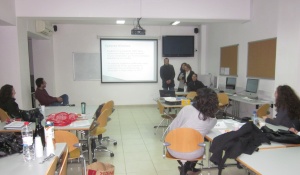Workshop about New Media at the Cyprus Technological University January 2012
Yiannis Laouris was invited on january 30, 2012 by the Dr. Christothea Herodotou from the Faculty of Applied Arts and Communication, Department of Communications and Internet Studies to deliver a 3-h course on new media in education. The title of the course was "Cypriot Children in cyberspace; Research & Recommendations."
Course Description
The delivery of this 3-h long course will require students to prepare. The actual course will be highly interactive and animated. Materials provided here are comprehensive; nevertheless students are expected to “discover” whatever is being done in Cyprus and report up-to-date findings. They are also expected to come up with innovative questions, formulate new hypotheses, recommend new approaches to promoting safer internet , and/or suggest new research agendas or projects.
Pre-course Requirements
Students are required to prepare for the course either individually or in groups of two. The following section summarizes important questions. Students should prepare a short Power point Presentation with a few slides on the subject to be used for a discussion. Presentations should not be longer than 5-7 minutes, after which the class will engage in an exploration of the data and the how and why one can derive one or another conclusion. Students are encouraged to come up with hypotheses that could be tested with the existing database.
Course Themes
The following are the themes on which the course will focus. Students are required to contact the instructor, choose their theme and prepare for their presentations. Each student will be expected to invest at least a few hours to prepare. The selection of the themes will be made on a first-come-first served approach.
Cross-country comparison of indices: Where in the world is Cyprus?
The student is expected to extract the graphs related to cross-country comparisons and highlight the “position” of Cyprus within Europe. Moreover, s/he is encouraged to draw attention to discrepancies and challenges. Digital Literacy: Where is Cyprus? Students is required to provide a short overview of the challenges regarding digital literacy with a focus on how the situation in Cyprus. (File: EU Kids Online_II_DigitalSkillsShortReport.pdf).
Connecting Generations: Parents’ attitudes towards safety
This year’s safer internet campaign focuses on “Connecting Generations: Discovering the Digital World Together”, a slogan originally proposed (and finally voted by all European Nodes) by the Cyprus Safer Internet Center. The student(s) is expected to study an online TV program with discussions about how researchers discovered that parents-children’s relations are a weak link in the campaign of safety and how the “connecting generations” concept can improve the campaign.. The program is available on 6 Youtube videos of the Sin Plin program; the first, “SID2011_SinPlin - Part 1 of 6,” is at:
Cypriot children’s usage of new media: Basic statistics
Student(s) is expected to extract the most important statistics on how Cypriot children of different ages and gender use new media. The presentation should be based on data to answer questions regarding differences that depend on gender, ager group and socio-economic status. (File: EU Kids Online_II_D4_FullFindings.pdf). From twenty to five most important internet safety tips Students will need to perform their research to come up with 20 internet safety tips and then focus on the 5 more important, which can either be taken out of the D 7.1 EU Kids Online Recommendations for Safety (File: EU Kids Online_II_D7_1_Recommendations_Safety.pdf) or their own justification for an alternative.
Social media on the rise: Special focus on Cyprus
Compare the times spent and the activities in which children are engaged within social media versus other media (i.e., games, Wikipedia, magazines, chatting etc). How do children in Cyprus use Facebook and what kind of personal information they reveal. Study materials include EU Kids Online Full Findings Report (File: EU Kids Online_II_D4_FullFindings.pdf) as well as a publications titled: Disclosure of personal and contact information by young people in social networking sites: An analysis using FacebookTM profiles as an example (Paper: * http://www.sfu.ca/cmns/courses/2011/260/1-Readings/Taraszow%20et%20al%20Disclosure%20of%20Personal%20Information.pdf)
Video Games and threads for Cyprus: What about “positive content”?
Student(s) is expected to define video game addiction and present statistics concerning the usage of video games in Cyprus. The presentation should provide answers to questions regarding gender differences, age differences, types of games used, knowledge or not of the system. Main resources: • http://www.saferinternet.org/web/guest/blog;jsessionid=9ADCB0D35433917872572DF3F3419BB1?p_p_id=homeBlog_WAR_insafeportlet&p_p_lifecycle=0&p_p_state=normal&p_p_mode=view&p_p_col_id=column-1&p_p_col_count=1&_homeBlog_WAR_insafeportlet_tag=positive+content&_homeBlog_WAR_insafeportlet_folksonomy=true& • http://www.video-game-addiction.org/ • http://www.video-game-addiction.org/symptoms-computer-addiction-teens.html • www.IdentifEye.org • www.Simsafety.eu
Top 10 myths about children’s online risks
The top 10 myths are summarized on page 42 of the EU Kids Online Final Report (File: EU Kids Online_II_FinalReport.pdf). For each myth, students should find the relevant supporting findings out of the Full Findings Report (File: EU Kids Online_II_D4_FullFindings.pdf) and show the respective statistics, tables and graphs.
Resources
Additional Readings & Resources Readings
